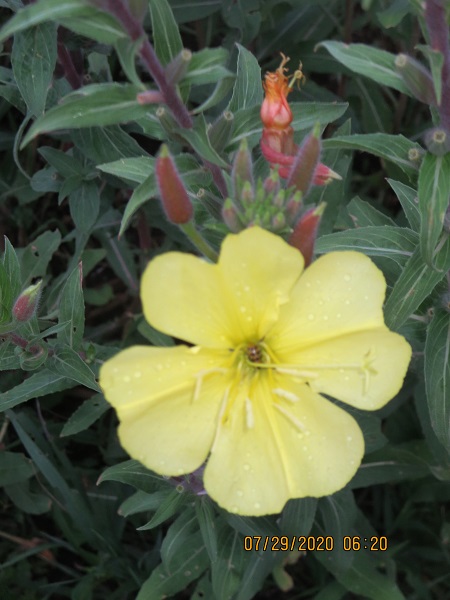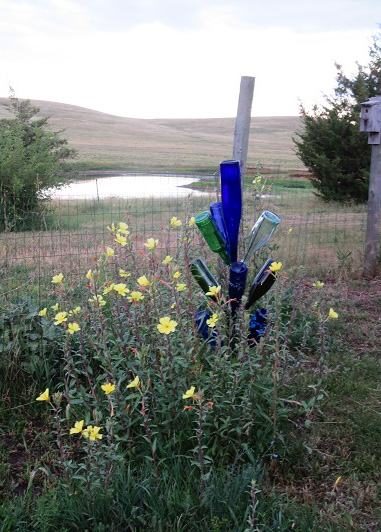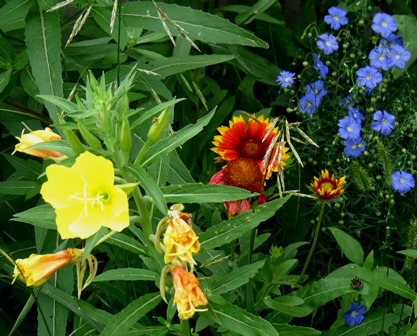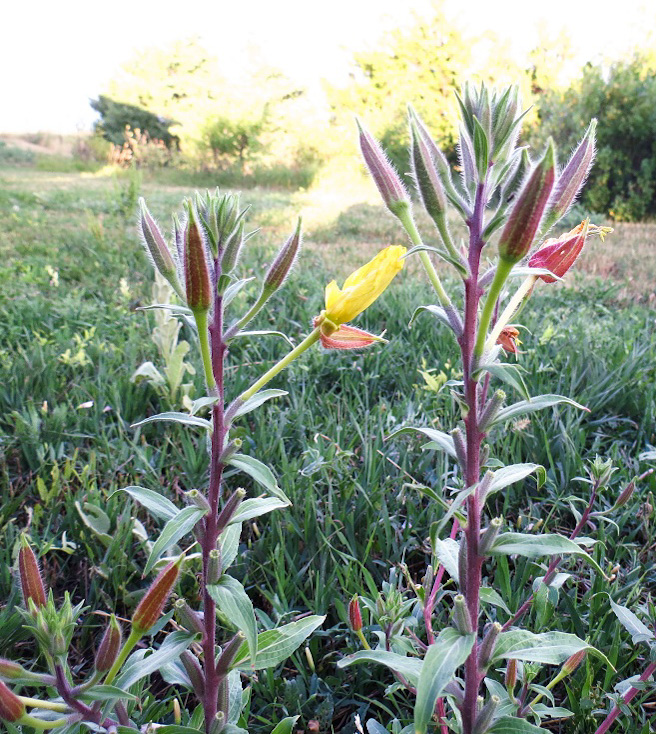In the yard at 5:43 on a dark morning, the sky is covered with clouds behind which a glorious sunrise has just vanished. Yet the evening primrose are blooming vivid yellow, like tall candles.
Ours is Oenothera biennis, Common evening primrose, a tall plant with large yellow blooms arranged most of the length of the stem. The “goblet-like” flowers in yellow, white or pink, each with four petals, are said to be lemon-scented, but they seem sweeter than that to me.
I’m not sure where mine originated, but they have scattered naturally. Night-blooming plants are said to attract moths for pollination, so we wonder if the gorgeous hummingbird moths we’ve been seeing are responsible for pollinating ours.
The plants reappear every year, but they don’t spread wildly as some do. I’ve recently learned that the plant takes 2 years to complete its life cycle, with basal leaves becoming established the first year, and flowering occurring the second. Ours have been blooming several years, in the same locations.
Experts say they do well in either sun or shade, and ours manage to survive even on the north and west sides of the house, which sometimes get punishingly hot in summer.
Once I started looking for information about Oenothera, I became fascinated by the details. It was apparently once cultivated for its “delectable roots,” which were said to have a light, peppery taste similar to salsify, and could be eaten raw or cooked like any other root vegetable. The one I tried, from a tiny plant, was so tough and fibrous as to be impossible to chew, and had no particular flavor. The plant is now often grown for its omega-6-containing seeds. I’ll try those later in the summer.
I was delighted to learn that Oenothera is native to North America but was taken to Europe in the 1600s, scientists surmise, where it has now naturalized. The plant has also traveled to many other parts of the world. I picture explorers delightedly tucking the plants into a tiny English garden, where its gold blooms lit a brick wall.
And it’s astonishingly adaptable. Depending on the variety, this plant – also known as coffee plant, golden candlestick, and a host of other nicknames – can be biennial, annual, or perennial.
Some of the dozens of varieties have an upright growth habit, reaching heights of 6 feet and a width of 24 inches, where others are used as ground cover or for container plantings, growing no higher than 6 inches. Various varieties, some of which are quite fragrant, do well in zones 3-11.
Native Americans used the whole plant for treating bruises and its roots for treating hemorrhoids. The leaves were made into medicines for minor wounds, gastrointestinal issues, and sore throats. Today, oil pressed from the plant’s seeds is marketed in capsule form to help a number of conditions including eczema, rheumatoid arthritis, premenstrual syndrome, and osteoporosis.
The gamma linolenic acid — a type of omega-6 fatty acid — contained within the oil is used by the body to regulate blood pressure and to keep the immune system functioning well.
Birds, perhaps seeking a little omega-6 of their own, enjoy eating the plant’s seeds, which is doubtless one way the plant spreads. Some folks use the seeds as one might use poppy seeds.
O. Berlandieri, or Mexican evening primrose, on the other hand, is a spreading perennial. It only grows to a height of about 18 inches. Native to Missouri, Nebraska, Kansas, Oklahoma, Texas, and Mexico, this plant will grow in infertile soil, with minimum water and full sun.
Evening primrose ‘showy’ (O. speciosa) also thrives in heat and is drought-tolerant. It grows 18 to 24 inches tall and displays pink, pale lavender, or white and pink flowers.
O. pallida, or pale evening primrose, is a low-growing biennial native to the western United States. I’ve have spotted some of these in the Great Plains Botanic Garden, located on my ranch. (See their website at www.GPNPS.org or find them on Facebook at Great Plains Native Plant Society Group).
If you are walking in the plains at sunrise or dusk, look for this gorgeous inhabitant.
Linda M. Hasselstrom
Windbreak House Retreats
Hermosa, South Dakota
© 2022, Linda M. Hasselstrom
# # #





Thanks Linda, for your observations and writings.
My friend gave me an evening primrose. It grows and blooms every other year. A random one came up by my shed. It’s bush like 💛 we Iive in Ohio